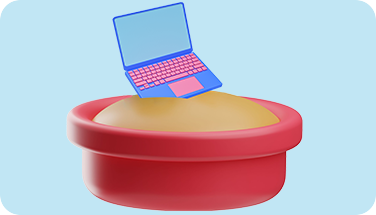Top reasons to set up ERP sandbox environments
What is an ERP sandbox?
“Sandbox environments” are a software convention in which a sectioned-off version of the solution is created in order to allow users and administrators to conduct test-and-learn exercises. Admins can push newer solutions (or versions of the same solution) to a small number of users, and a userbase can try out and learn new systems without mistakes causing lasting issues in terms of data loss or editing.

Just like a real sandbox, it’s a place you can play around without any real consequences.
Generally speaking, a sandbox of your ERP environment will take the form of a full clone of your ERP platform and your dataset in which your team can make changes, try out new features, test and deploy new software and integrations, pilot plugins and new apps, and train staff without real business data being affected. Any changes you make can be undone by rebooting the sandbox to its original state (which allows for further testing from a “blank slate” starting point.)
Why would you want to use an ERP sandbox?
Sandbox environments create a buffer against IT risk by making changes to your system much less likely to result in unintended consequences for the “live” business. These risks can be anything from those associated with new 3rd party apps to outages caused by changes or errors. Sandboxing also makes catching potential data breaches or security vulnerabilities before they actually affect the business considerably easier.
Click to read How Cloud ERP can change your organization for the better gated
Test new software and integrations safely before launch
Sandboxing makes it easy for your IT teams (and individual users) to performance test new software and integrations on a fully-functional duplicate of your actual ERP system. Protecting your operations from any adverse effects and ensuring that new tools don’t negatively affect the performance of your existing solutions.
Train your staff and let them acclimate
Major changes to your business’s operations or IT environment are like any other change management project - they have a learning curve and you can’t expect your people to simply hit the ground running. A sandbox provides you with a perfect place to train your users, define procedures, create process documents, and allow people to become comfortable not just with the system itself, but with the ways they’ll be expected to use it.
Innovate and adapt quickly
The ability to export a copy of your working system and experiment with it at any time provides a powerful platform for innovation and iterative improvement. From adapting workflows to trialing new automations and customizations or testing new features, sandboxing provides a safe environment in which to experiment free from negative consequences and adverse impacts on your organizational data, your people’s day-to-day, and your customers’ outcomes.
When might you need to rely on a sandbox environment?
During any digital transformation project
In an environment characterized by extreme uncertainty and disruption, the ability to experiment with new ways of working and rapidly test and implement new approaches are a vital component of business agility. Although organizations have always relied on agility to survive and thrive, in the post-pandemic world agility and adaptability are more important than ever.
Digital transformation is key to providing this kind of agility - but with many organizations still relying on complex ERP environments with all manner of custom integrations, data silos, and disparate architectures, predicting the effects of major system changes is often difficult or impossible.
In any digital transformation project, sandboxing will represent a vital tool when it comes to maintaining your ability to change and adapt without exposing your organization to unpredictable and risky effects.
ERP transformation and implementation
Regardless of whether the end goal of such a project is to create a single, organization-wide consolidated ERP environment, streamline your operating model and business processes, or simply gain more control and visibility of your data, implementing a new ERP system is likely to be an unpredictable process. While it might lengthen the timeline and add to the cost of your implementation project, in the long run establishing a test environment can lead to substantial long-term savings in terms of time and money.
Cloud migration
Best practice for migration of ERP to the cloud is very clear on the idea that you don’t want to end up constantly playing the “system integrator” role of a complex hybrid cloud estate.
In the long run, this puts the brakes on enterprise agility and can leave your ERP cloud migration team bogged down in maintenance and admin – precisely what a cloud solution is supposed to put an end to.
This means that an ERP cloud migration project is usually a matter of identifying and migrating critical systems first while being ready and willing to go “all in” as quickly as possible.
Depending on your organization’s relative maturity when it comes to several different axes (from your adoption of AI and machine learning to your relative data maturity and the size and complexity of your digital estate), this will mean that your cloud migration is likely to be a multi-stage process, with different components moving at different times.
The complexity of such a project almost demands a safe testing environment from which to jump off to a live implementation - meaning you’ll put the new system through its paces in the sandbox before rolling it out fully.
When sunsetting your legacy systems
As anyone who’s been involved in such a project will know, bidding farewell to legacy systems is almost never a simple prospect. Legacy systems have a tendency to make themselves indispensable - and often in ways that nobody quite expects. It’s not at all uncommon to sunset a legacy platform only to immediately discover a capability gap emerging in a key area.
However, the fear of such an eventuality - combined with ordinary organizational inertia - often causes companies to hang on to legacy systems long after they should have been put out to pasture.
But the correct use of your sandbox environment can actually help you to overcome the anxiety associated with the end-of-life process. Your sandbox environment can be a key tool in defining which parts of your legacy system are and aren’t critical to maintaining your operations, scoping requirements for new systems, and experimenting with various different tools and methods that can allow you to close the gaps.
How can Unit4 help you?
Unit4 have been creating enterprise software systems for over 40 years - meaning we’ve been building ERP solutions since long before the term “ERP” has actually been in use. We have a unique body of knowledge in system evolution and in the deployment and implementation of ERP systems - particularly in people-centric and project-centric organizations.
Our Industry Models for implementation incorporate everything your organization needs in order to ensure your new solution is deployed and operational quickly (in fact, they can cut the time of a typical ERP implementation project in half.)
Our ERP, FP&A, HCM, S2C, and PSA solutions are built to be adaptive and extremely flexible thanks to our modular design approach and low-code customization capabilities; and we provide even your least technical users with the tools they need to build the tools they need to do their jobs in the way that lets them add value.
To discover what our solutions can do for yourself, check out our dedicated product pages now or click here to book a demo.





